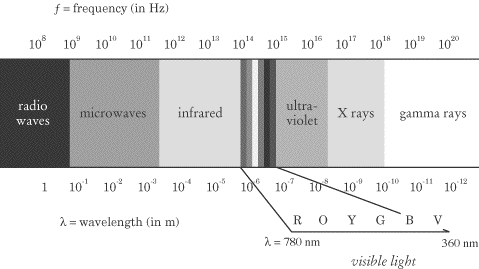Lesson: Chapter - 18
The Electromagnetic Spectrum
Electromagnetic waves travel through a vacuum at the speed of light,
c = 300 × 108
m/s. As we’ll see in the next chapter, this is the fastest speed there is:
anything faster resides at present only in the realm of theoretical speculation.
Because the speed of EM waves is constant, we can calculate a wave’s frequency
if we know its wavelength, and vice versa:

Wavelength and frequency are the only qualities that distinguish one kind of EM
wave from another. As a result, we can list all the kinds of EM waves on a
one-dimensional graph called the electromagnetic spectrum.
div>

A higher frequency—and thus a shorter wavelength—corresponds to a wave with more
energy. Though all waves travel at the same speed, those with a higher frequency
oscillate faster, and a wave’s oscillations are associated with its energy.
Visible light is the part of the electromagnetic spectrum between roughly
400 and 700
nanometers (1 nm = 10-9 m). When EM waves with these wavelengths—emitted by the sun, light bulbs, and
television screens, among other things—strike the retina at the back of our eye,
the retina sends an electrical signal to our brain that we perceive as color.
Back
Next
Next to display next topic in the chapter.
Practice Questions
Video Lessons and 10 Fully Explained Grand Tests
Large number of solved practice MCQ with explanations. Video Lessons and 10 Fully explained Grand/Full Tests.